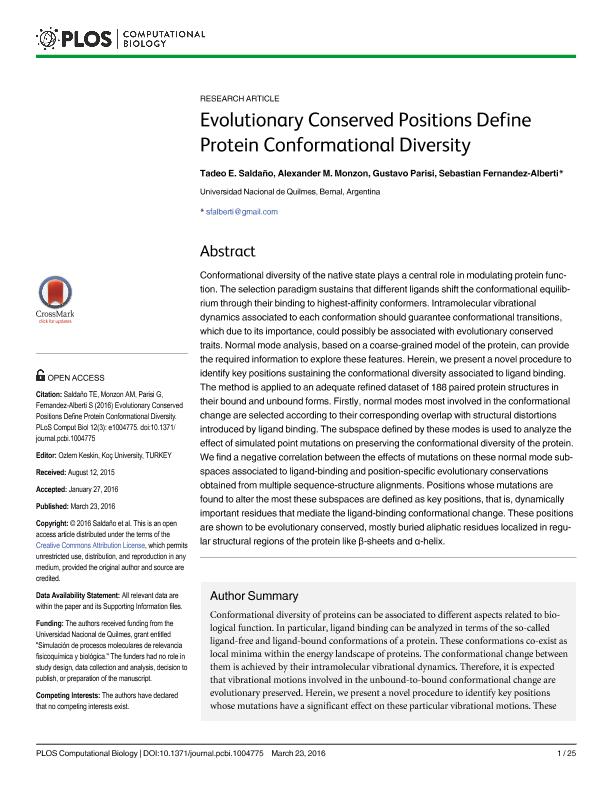Mostrar el registro sencillo del ítem
dc.contributor.author
Saldaño, Tadeo Enrique

dc.contributor.author
Monzón, Alexander

dc.contributor.author
Parisi, Gustavo Daniel

dc.contributor.author
Fernández Alberti, Sebastián

dc.date.available
2019-10-11T19:01:08Z
dc.date.issued
2016-03
dc.identifier.citation
Saldaño, Tadeo Enrique; Monzón, Alexander; Parisi, Gustavo Daniel; Fernández Alberti, Sebastián; Evolutionary Conserved Positions Define Protein Conformational Diversity; Public Library of Science; Plos Computational Biology; 12; 3; 3-2016; 1-25
dc.identifier.issn
1553-734X
dc.identifier.uri
http://hdl.handle.net/11336/85767
dc.description.abstract
Conformational diversity of the native state plays a central role in modulating protein function. The selection paradigm sustains that different ligands shift the conformational equilibrium through their binding to highest-affinity conformers. Intramolecular vibrational dynamics associated to each conformation should guarantee conformational transitions, which due to its importance, could possibly be associated with evolutionary conserved traits. Normal mode analysis, based on a coarse-grained model of the protein, can provide the required information to explore these features. Herein, we present a novel procedure to identify key positions sustaining the conformational diversity associated to ligand binding. The method is applied to an adequate refined dataset of 188 paired protein structures in their bound and unbound forms. Firstly, normal modes most involved in the conformational change are selected according to their corresponding overlap with structural distortions introduced by ligand binding. The subspace defined by these modes is used to analyze the effect of simulated point mutations on preserving the conformational diversity of the protein. We find a negative correlation between the effects of mutations on these normal mode subspaces associated to ligand-binding and position-specific evolutionary conservations obtained from multiple sequence-structure alignments. Positions whose mutations are found to alter the most these subspaces are defined as key positions, that is, dynamically important residues that mediate the ligand-binding conformational change. These positions are shown to be evolutionary conserved, mostly buried aliphatic residues localized in regular structural regions of the protein like β-sheets and α-helix.
dc.format
application/pdf
dc.language.iso
eng
dc.publisher
Public Library of Science

dc.rights
info:eu-repo/semantics/openAccess
dc.rights.uri
https://creativecommons.org/licenses/by-nc-sa/2.5/ar/
dc.subject
CONFORMATIONAL DIVERSITY
dc.subject
PROTEINS
dc.subject
EVOLUTION
dc.subject
DYNAMICS
dc.subject.classification
Bioquímica y Biología Molecular

dc.subject.classification
Ciencias Biológicas

dc.subject.classification
CIENCIAS NATURALES Y EXACTAS

dc.title
Evolutionary Conserved Positions Define Protein Conformational Diversity
dc.type
info:eu-repo/semantics/article
dc.type
info:ar-repo/semantics/artículo
dc.type
info:eu-repo/semantics/publishedVersion
dc.date.updated
2019-10-08T12:12:26Z
dc.journal.volume
12
dc.journal.number
3
dc.journal.pagination
1-25
dc.journal.pais
Estados Unidos

dc.journal.ciudad
San Francisco
dc.description.fil
Fil: Saldaño, Tadeo Enrique. Consejo Nacional de Investigaciones Científicas y Técnicas; Argentina. Universidad Nacional de Quilmes; Argentina
dc.description.fil
Fil: Monzón, Alexander. Consejo Nacional de Investigaciones Científicas y Técnicas; Argentina. Universidad Nacional de Quilmes; Argentina
dc.description.fil
Fil: Parisi, Gustavo Daniel. Consejo Nacional de Investigaciones Científicas y Técnicas; Argentina. Universidad Nacional de Quilmes; Argentina
dc.description.fil
Fil: Fernández Alberti, Sebastián. Consejo Nacional de Investigaciones Científicas y Técnicas; Argentina. Universidad Nacional de Quilmes; Argentina
dc.journal.title
Plos Computational Biology

dc.relation.alternativeid
info:eu-repo/semantics/altIdentifier/url/https://journals.plos.org/ploscompbiol/article?id=10.1371/journal.pcbi.1004775
dc.relation.alternativeid
info:eu-repo/semantics/altIdentifier/doi/https://doi.org/10.1371/journal.pcbi.1004775
Archivos asociados
